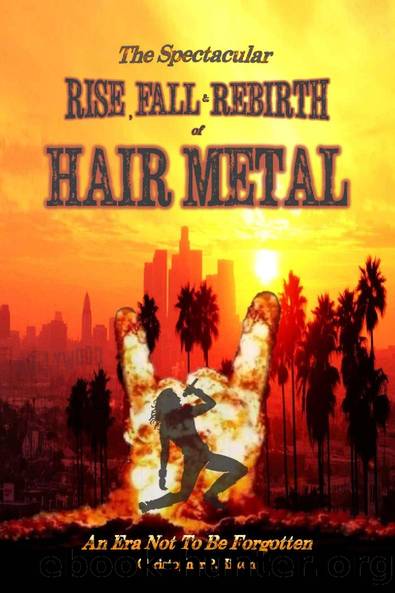The Rise, Fall and Rebirth of Hair Metal by Christopher P. Hilton

Author:Christopher P. Hilton [Hilton, Christopher P.]
Language: eng
Format: epub
Publisher: Bowker
Published: 2020-03-20T00:00:00+00:00
Chapter 16
Power to the Music
(1994)
By 1994, it had been five long years since hair metal giants Mötley Crüe issued their last full-length studio album, Dr. Feelgood, which had gone all the way to No. 1 on the Billboard Albums chart and spawned a massive two-year world tour that firmly established the band alongside Guns Nâ Roses as kings of the hair metal and hard rock world, at the time. Mötley Crüe then kept their momentum active by releasing the No. 2 charting greatest hits compilation Decade of Decadence in 1991. Mötley had finally reached the top of the mountain ten years after first coming together during hair metalâs onset in 1981.
However, after Vince Neil departed (or was ousted) from the band in February 1992, Mötley Crüe suddenly found themselves without a singer at the peak of their fame. Neil forged ahead with his solo career, dropping the terrific Exposed album in 1993 along with a somewhat successful tour in support. All the while, however, things back at the Mötley camp were quiet as a church mouse.
Finally, in late 1993, an unconfirmed report surfaced that Mötley Crüe had hired a relatively unknown singer by the name of John Corabi. (Remember, this was before the internet and social media, so news and details were sparse and hard to come by for the average fan.)
It was also rumored the band was busy hard at work on a new album. But so much had changed in the five years since Dr. Feelgood (not just Mötleyâs singer, but the entire musical and cultural landscape), many wondered what the Crüe would even sound like when (if) they reemerged in 1994. As it turned out, the band could not have chosen a new frontman more different than Neil.
In truth John Corabi wasnât exactly an unknown to those close to the scene. He had led the hard rock outfit Agora in the late â80s, a popular outfit that succeeded in establishing a fairly big following on the Sunset Strip. Corabi then went on to form The Scream in 1989, and the group released their very cool debut, Let It Scream, in 1991.
Upon hearing the Let It Scream album in 1993 and coming away impressed, Nikki Sixx reached out to Corabi to see if the underground singer might be interested in auditioning for the mighty Mötley Crüe. Corabi was clearly talented, but the fit could be understandably questioned as both his style and approach were starkly different than what Neil had brought to the table.
Neil was always the blonde, party-boy, chick-magnet, good-times guy with the high-pitched, clean vocals. Corabi, on the other hand, was more on the dark and reserved side, with a gravelly, coarse, blues-based, raspy sound. That said, Corabi did possess a more powerful, versatile voice and was assuredly more technically proficient. Further, the singer also played rhythm guitar and was an accomplished songwriter, adding a couple of exciting new ingredients to Mötley Crüeâs traditional formula.
In addition to the change that was Corabi, the musical landscape had mutated into a completely different animal in 1994 versus what it had been just a few years prior.
Download
This site does not store any files on its server. We only index and link to content provided by other sites. Please contact the content providers to delete copyright contents if any and email us, we'll remove relevant links or contents immediately.
The Goal (Off-Campus #4) by Elle Kennedy(12435)
Kathy Andrews Collection by Kathy Andrews(10521)
Diary of a Player by Brad Paisley(6866)
What Does This Button Do? by Bruce Dickinson(5527)
Assassin’s Fate by Robin Hobb(5238)
Big Little Lies by Liane Moriarty(4881)
Pale Blue Dot by Carl Sagan(4003)
Sticky Fingers by Joe Hagan(3454)
The Heroin Diaries by Nikki Sixx(2932)
The Death of the Heart by Elizabeth Bowen(2902)
Beneath These Shadows by Meghan March(2718)
The Help by Kathryn Stockett(2704)
Confessions of a Video Vixen by Karrine Steffans(2675)
How Music Works by David Byrne(2527)
Jam by Jam (epub)(2489)
Harry Potter 4 - Harry Potter and The Goblet of Fire by J.K.Rowling(2416)
Strange Fascination: David Bowie: The Definitive Story by David Buckley(2367)
Petty: The Biography by Warren Zanes(2238)
Darker Than the Deepest Sea by Trevor Dann(2208)
